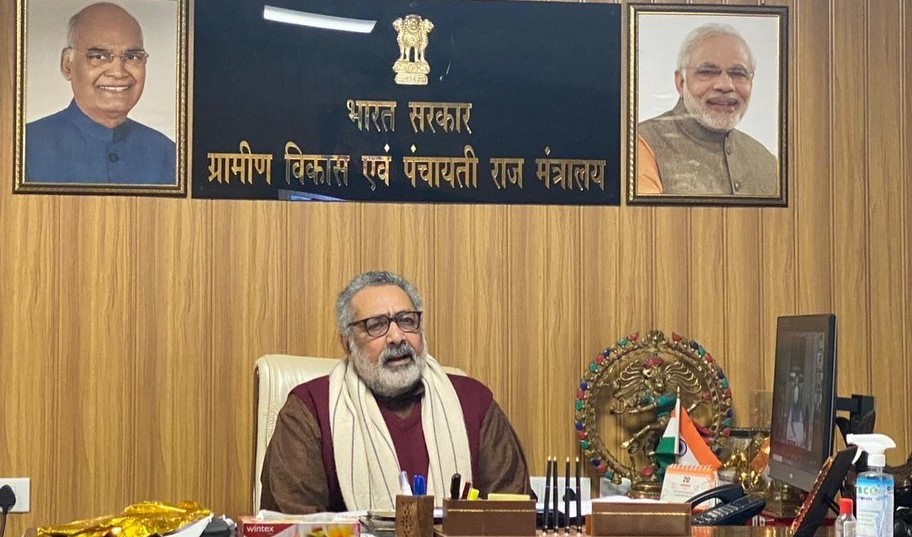New Delhi: All Panchayati Raj Institutions should have a vision for respective Panchayat for the next twenty-five years till India’s centenary of Independence in 2047; should embark on formulating a master plan for all-round development and should take all possible efforts to boost local infrastructure, other developmental requirements, employment opportunities and resource base of Panchayats, exhorted Giriraj Singh, Minister of Rural Development & Panchayati Raj while releasing the revised Rural Area Development Plan Formulation and Implementation (RADPFI) Guidelines prepared by Ministry of Panchayati Raj today.
Giriraj Singh called upon Panchayati Raj Institutions to take the Rural Area Development Plan Formulation and Implementation (RADPFI) Guidelines as a “Sankalp Patra” by leveraging an active ownership approach.
Addressing on the occasion, Giriraj Singh said that the RADPFI Guidelines released today have definitely been prepared keeping in mind the vision to transform rural India and to ensure empowerment of rural India and to promote rural prosperity. Now the need is that Panchayat and all concerned should move forward with a firm determination in the direction for efficient and smooth implementation of the developmental plans at grassroots level. He said that RADPFI Guidelines will help in improving the quality of life in rural areas.
Singh said that Prime Minister Narendra Modi has set the goal in the context of Azadi Ka Amrit Mahotsav to take effective steps to realise the dreams of making Panchayats powerful and vibrant institutions. Along with Vision 2047, we also must achieve the Sustainable Development Goals set up by the United Nations and intended to be achieved by the year 2030. Prime Minister has called for laying the groundwork for new resolutions in the perspective of Panchayats and move forward with new resolutions in a coordinated and holistic manner.
The Minister said that there is a greater need of “change in approach” and “change in mindset” when we deliberate in totality towards proposing a strategy and plan for development of Panchayats. He requested the States/UTs to take everyone on-board and to organise seminars to familiarize all the concerned officers of the Central and State Governments, elected representatives and functionaries of Panchayati Raj Institutions and other stakeholders so that RADPFI Guidelines are adopted and implemented in right spirit.
The Minister said d that the revised RADPFI guidelines would serve as the basis for rural transformation and enable effective Land use planning in rural areas. He also added that the release of RADPFI guidelines would supplement the efforts of the Central Government such as the SVAMITVA Scheme of Ministry of Panchayati Raj and RURBAN Mission of Ministry of Rural Development and facilitate better utilisation of Geospatial information.
Kapil Moreshwar Patil, Minister of State for Panchayati Raj said that the formulation of revised RADPFI guidelines is a continuation to Ministry’s efforts towards promotion of Spatial rural planning and would create pathways for rural transformation by developing a perspective for long term planning in villages.
Patil said that the RADPFI Guidelines has been unveiled to ensure ease of living in villages and help minimizing migration to big cities by providing all necessary infrastructure and facilities and also resources and opportunities for livelihood in rural areas. Kapil Moreshwar Patil suggested that the best performing Panchayats, based on the implementation of RADPFI guideline, should also be considered for award on the occasion of National Panchayati Raj Day with an aim to creating an environment of healthy competition among the villages for their all-round development.
Sunil Kumar, Secretary, Ministry of Panchayati Raj highlighted that the revised RADPFI Guidelines include Village Planning Scheme (VPS) on the lines of Town Planning Schemes in urban areas; provisions of linking Gram Panchayat Development Programme (GPDP) with Spatial Land Use Planning, spatial standards for Gram Panchayat development etc. Shri Nagendra Nath Sinha, Secretary, Ministry of Rural Development appreciated the efforts of Ministry of Panchayati Raj and stated that these guidelines would augment development of vibrant economic clusters in rural areas, which would contribute to the socio-economic development of rural areas.
During the event, a brief presentation was made by Prof. N Sridharan, Director, School of Planning and Architecture, Bhopal in which he highlighted the salient points of revised RADPFI Guidelines and laid down a vision for social upliftment of villages through development of Master Plans for Gram Panchayats. The event also saw participation from Dr. Meenakshisundaram, Former Secretary, Ministry of Rural Development and Shri Avinash Mishra, Adviser, NITI Aayog, who have played a key role in finalisation of revised RADPFI Guidelines as Chairman and Member respectively of Inter-Ministerial Committee.
The release of these Guidelines would certainly give direction to the process of planned development in various sectors such as physical and social infrastructure, economic activities, road and transport connectivity, land values and anticipated economic activities and will aid towards a workable solution for conversion of agricultural to non-agricultural purpose for planned development. It is expected that these revised guidelines would provide guidance to the State Town and Country Planning Departments, State Rural Development and Panchayati Raj Departments and a host of other offices located at the district/block level which are responsible for the planned infrastructure development, both physical and social in the villages.
Chandra Shekhar Kumar, Additional Secretary, MoPR, Khushwant Singh Sethi, Joint Secretary, MoPR Shri Alok Prem Nagar, Joint Secretary, MoPR, Shri (Dr.) Bijaya Kumar Behera, Economic Adviser, MoPR and other Senior Officers of the Government of India graced the occasion. Senior officers from the State Panchayati Raj Departments, representatives from reputed academic and research institutes of Architecture and Planning also attended the event virtually.




